ESA's historic Rosetta mission to explore Comet 67P/Churyumov-Gerasimenko ended in dramatic fashion on September 30th.
View from Rosetta's Controlled Descent
From NASA: "A new image of comet 67P/Churyumov-Gerasimenko was taken by the European Space Agency's (ESA) Rosetta spacecraft shortly before its controlled impact into the comet's surface on Sept. 30, 2016. Confirmation of the end of the mission arrived at ESA's European Space Operations Center in Darmstadt, Germany, at 4:19 a.m. PDT (7:19 a.m. EDT / 1:19 p.m. CEST) with the loss of signal upon impact."
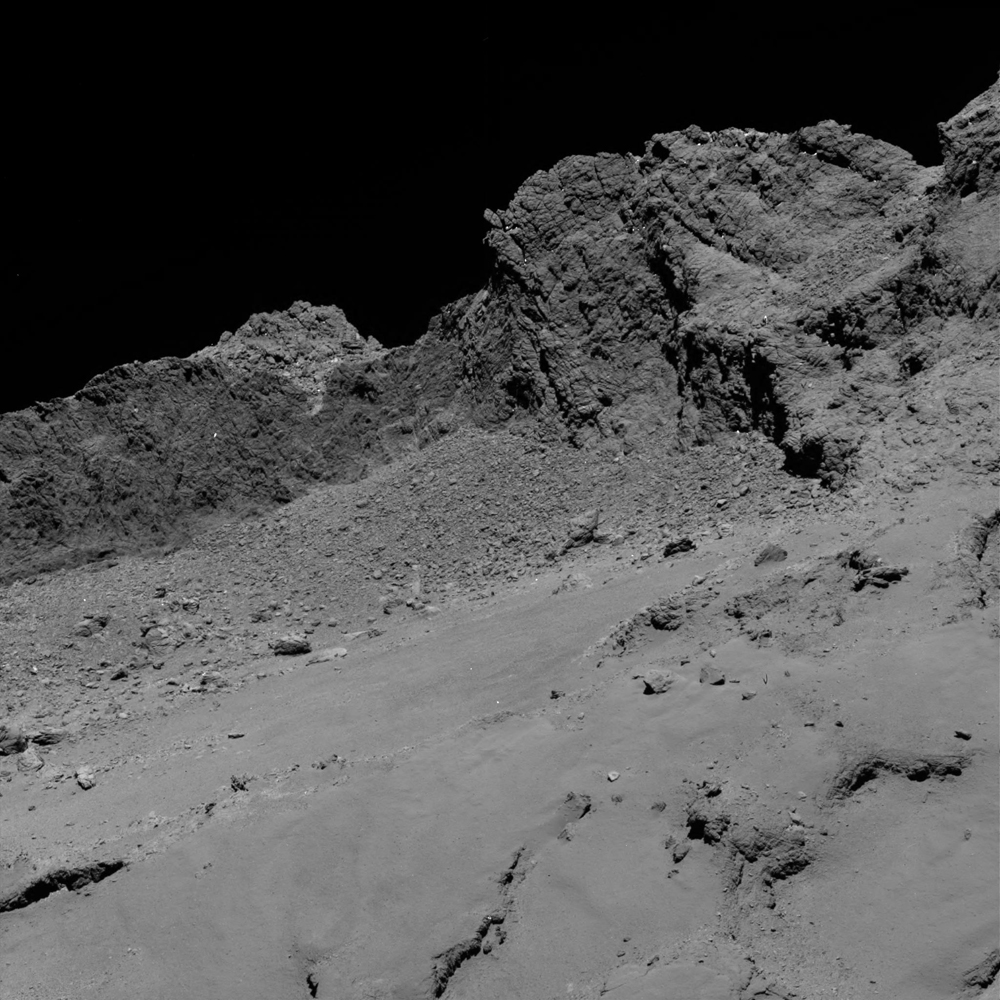
ESA
| Watch the end of the Rosetta mission: The European Space Agency and NASA Television aired the conclusion to the Rosetta mission. The Rosetta mission will end with the controlled decent of the spacecraft onto the surface of comet 67P/Churyumov-Gerasimenko at 7:19 a.m. EDT on September 30th. |
Rosetta's Finale Ends an Amazing Mission
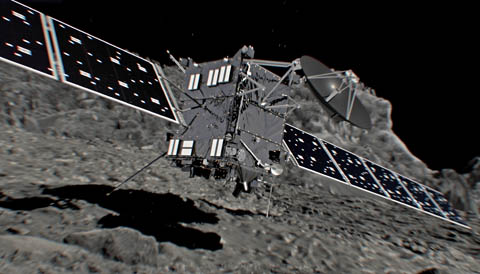
ESA / ATG medialab
An amazing mission of cometary exploration came to a climactic end, as the European Space Agency's Rosetta spacecraft came to rest on Comet 67P/Churyumov-Gerasimenko on September 30th.
Launched on March 2, 2004, from Kourou, French Guiana, atop an Ariane V rocket, it took Rosetta 10 years to arrive at Comet 67P. This epic journey included flybys of Mars, Earth, and asteroids 2867 Steins and 21 Lutetia, after which Rosetta was placed in a risky hibernation mode for several years. Reawakened on January 20, 2014, Rosetta successfully phoned home and got to work.
Thanks to Rosetta, Comet 67P is now arguably the most studied comet in the history of planetary science.
Don't Call it an Impact
Until now, Rosetta has kept a good distance from Comet 67P, but in its last days, the final orbits of Rosetta brought it as close as 1 kilometer from the surface of the comet.
Rosetta executed its low-speed collision maneuver 20 km above the comet's surface late on the evening of Thursday, September 29th. Contact occured later the next day, with loss of signal confirmed at 7:19 a.m. EDT. Rosetta was expected to come to rest on the comet at a velocity of about 1 meter per second. That's about 3.6 km (2.2 miles) per hour, equivalent to a slow walking pace.
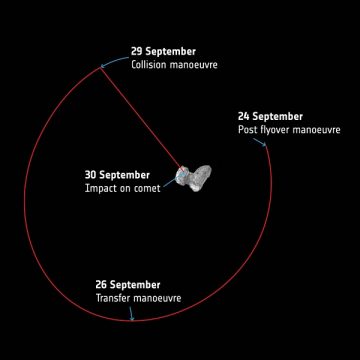
ESA
“We have observations/measurements of the comet at all scales, from kilometers down to 100s of nanometers, and this is giving us a wonderful insight into how the comet was created from the interstellar dust,” says project scientist Matt Taylor (ESA) “We have shown that the comet was formed from two smaller similar cometesimals that collided at low velocity.”
The Ma'at region that Rosetta targeted is dotted with several active sink hole-style pits, measuring about 100 m wide by 50 m deep (imagine a football field-sized hole as deep as a typical water tower is high). Researchers aimed to bring Rosetta down on a smooth plain between the Ma'at 02 and Ma'at 03 depressions, as shown in the image below, in hopes of peering inside them.
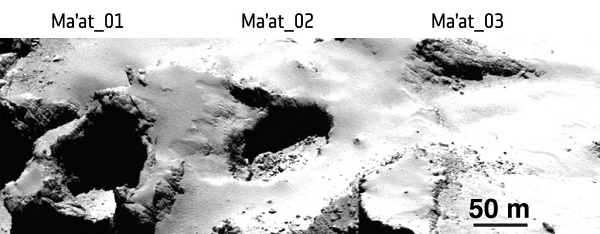
ESA / Rosetta / MPS for OSIRIS Team / UPD / LAM / IAA / SSO / INTA / UPM / DASP / IDA
Pits on Comet 67P show strange meter-sized nodules sometimes called "goosebumps." Scientists believe these lumps could be cometesimals which merged together to create the comet during the origin of the early solar system.
Instruments continued to measure gas, dust, and plasma all the way down during Rosetta’s descent, including during the 2 km closest to the comet, where some particles and ions in the coma begin accelerating toward the comet's tail. “This is something we have never done with Rosetta,” Taylor says.
The mission team christened the Ma'at 02 pit as Deir el-Medina, after an ancient pit in Egypt that proved to be a modern archaeological treasure trove.
Science and the Final Days of Rosetta
The Rosetta mission provides proof that big projects spanning decades can pay off. We've learned about the dynamic processes on comets that turn them into beautiful celestial spectacles.
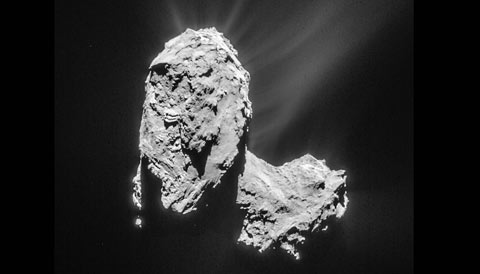
ESA / Rosetta / NAVCAM
Rosetta has also shown that water ice on Comet 67P contains three times more deuterium than water on Earth, a finding that rules out primordial comets as the predominant source of Earth's water. Rosetta did, however, discover glycine and other complex compounds on Comet 67P, offering a possible source for delivering organic compounds to early Earth.
And just within a month of the mission's end, Rosetta amazed us once again on September 5th, as the team released images of the Philae lander wedged in a dark crack on the comet's surface. This answered a lingering mystery as to just why Philae had a such rough time phoning home, as it received little sunlight to charge its batteries.
Will we hear from Rosetta again, if it survives surface contact? “No, the spacecraft will be commanded to not try to recontact Earth,” Says Taylor. “As Jim Morrison once said: 'This is the end . . . beautiful friend.'”
Still, it's fun to wonder just what the final fate of Rosetta and Philae might be over the coming millennia. Discovered in 1969, Comet 67P/Churyumov-Gerasimenko orbits the Sun every 6.44 years, its distance ranging from 1.2 to 5.7 astronomical units (a.u., the distance between Earth the Sun). Most likely, the twin lobes of Comet 67P will one day break apart, perhaps allowing Philae and Rosetta to drift free and derelict around the Sun.
Congrats to ESA and the Rosetta team on an amazing and inspiring mission, as Rosetta joins Philae on a final strange and exotic resting place on the surface of a comet.
 7
7









Comments
Zigarro
September 25, 2016 at 1:25 pm
"Will we hear from Rosetta again, if it survives surface contact? “No, the spacecraft will be commanded to not try to re-contact Earth,” Says Taylor." <<< Why??
You must be logged in to post a comment.
David DickinsonPost Author
September 26, 2016 at 10:31 am
That's straight from the PI... I know that Rosetta wasn't intended to perform surface ops, and does not have a steerable dish (in space, the entire spacecraft must be oriented at the Earth to send and receive data).
Thanks,
Dave Dickinson
You must be logged in to post a comment.
Lindsay
September 30, 2016 at 4:23 pm
Great report!
I assume you meant the comet has three times more heavy water (DHO and D2O) than water; but couldn't the excess deuterium be caused by preferential ablation of the lighter water over the eons by solar/cosmic wind?
You must be logged in to post a comment.
Jim-Baughman
September 30, 2016 at 8:33 pm
@Lindsay—
The water sampled from the comet was from the plumes, which originate from under the surface layer and so have been protected from direct exposure to the sun, thus no chance for preferential ablation. The surface of P67 is black as soot—no ice is exposed. We only see a nice gray surface because of image processing.
You must be logged in to post a comment.
Ajwoodhall
October 1, 2016 at 8:44 am
I'm puzzled by the continuing of existence of comets - if even a small amount of mass is lost at each journey around the Sun, it must add up to an enormous amount in the past 4.5 billion years. Do comets continue to top up their mass from the Ort cloud ?
You must be logged in to post a comment.
David DickinsonPost Author
October 3, 2016 at 11:53 am
I would say that periodic comets captured in brief inner solar system orbits have their days (or at least, eons) numbered, vs the vast reservoir of comets in the Oort cloud.
You must be logged in to post a comment.
Graham-Wolf
October 2, 2016 at 7:26 pm
WOW, David.
Those final photos are absolutely mind-blowing awesome.
We got an excellent TV report here in New Zealand, during the weekend. Top marks to the BBC.
Photo resolution as good, as that expected from a low altitude drone!
The Rosetta Mission was worth every cent spent on it.
Well done folks... a high-five from me.
Best wishes from NZ:- Graham W. Wolf.
You must be logged in to post a comment.
You must be logged in to post a comment.